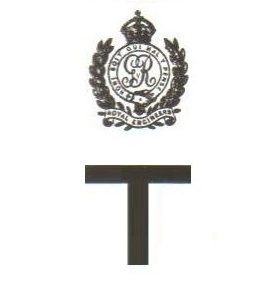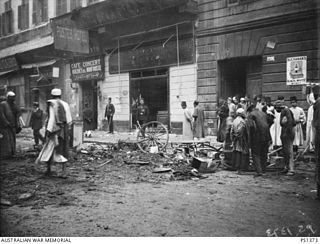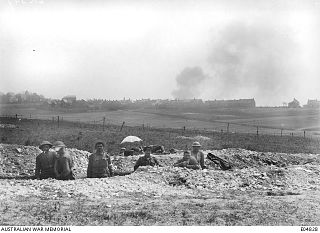 W
WIn Australia, the outbreak of World War I was greeted with considerable enthusiasm. Even before Britain declared war on Germany on 4 August 1914, the nation pledged its support alongside other states of the British Empire and almost immediately began preparations to send forces overseas to engage in the conflict. The first campaign that Australians were involved in was in German New Guinea after a hastily raised force known as the Australian Naval and Military Expeditionary Force was dispatched from Australia to seize German possessions in the Pacific in September 1914. At the same time another expeditionary force, initially consisting of 20,000 men and known as the First Australian Imperial Force (AIF), was raised for service overseas.
 W
WThe 1st Australian Tunnelling Company was one of the tunnelling companies of the Royal Australian Engineers during World War I. The tunnelling units were occupied in offensive and defensive mining involving the placing and maintaining of mines under enemy lines, as well as other underground work such as the construction of deep dugouts for troop accommodation, the digging of subways, saps, cable trenches, and underground chambers for signals and medical services.
 W
WThe 2nd Australian Tunnelling Company was one of the tunnelling companies of the Royal Australian Engineers during World War I. The tunnelling units were occupied in offensive and defensive mining involving the placing and maintaining of mines under enemy lines, as well as other underground work such as the construction of deep dugouts for troop accommodation, the digging of subways, saps, cable trenches and underground chambers for signals and medical services.
 W
WThe following is a list of forces involved in the Battle of Amiens of World War I fought from August 8 to August 11, 1918.
 W
WThe Amiens Gun is a German 28-centimetre (11 in) railway gun that was captured by the Australian Imperial Force during World War I and returned to Australia as a war trophy. The 28 cm SK L/40 "Bruno" gun was placed on public display on 26 March 1920 adjacent to the Central railway station, Sydney. While the gun's carriage was scrapped during the 1960s, the gun barrel remains on display at the Australian War Memorial in Canberra.
 W
WThe Australian Army was the largest service in the Australian military during World War I. The First Australian Imperial Force (AIF) was the Army's main expeditionary force and was formed from 15 August 1914 with an initial strength of 20,000 men, following Britain's declaration of war on Germany. Meanwhile, the separate, hastily raised 2,000-man Australian Naval and Military Expeditionary Force (AN&MEF), landed near Rabaul in German New Guinea on 11 September 1914 and obtained the surrender of the German garrison after ten days; it later provided occupation forces for the duration of the war. In addition, small military forces based on the pre-war Permanent Forces and part-time Citizen Forces were maintained in Australia to defend the country from attack.
 W
WWhen the First World War ended in November 1918, thousands of Australian servicemen were in Europe as members of the First Australian Imperial Force (AIF) and many remained until the spring of 1919. In England, a new first-class cricket season was planned, the first since 1914, and an idea that came to fruition was the formation of an Australian touring side made up of servicemen. Agreement was reached with the Australian Corps HQ in London, commanded by Field Marshal William Birdwood, 1st Baron Birdwood, and the Australian Imperial Force Touring XI was formed, initially under the captaincy of pre-war Test player Charlie Kelleway. Kelleway departed after only six matches following a dispute about the fixtures list. A players' meeting elected future Test player Herbie Collins as team captain for the remainder of the tour, despite the fact that Collins' military rank was lance corporal and there were seven officers in the party. The bulk of the team remained intact for nearly nine months from May 1919, playing 33 matches in Great Britain, ten in South Africa on their way home and then another three in Australia itself before disbanding in February 1920. Of the 46 matches, 39 are adjudged first-class and the team had only four defeats, all of these in England. The players lived on their army pay and all profits from gate money went to an AIF Sports Control Board.
 W
WThe Battle of the Wazzir was the name given to several riots of Australian, British and New Zealand troops in Cairo, Egypt, during World War I. The main incident occurred on 2 April 1915, but a smaller incident also took place on 31 July that year. In the aftermath of the war, another incident took place in February 1919.
 W
WThe Berrima Correctional Centre is an Australian prison, located at Berrima, New South Wales. The Centre was operational between 1839 and 2011 with a number of breaks in between, and was re-opened in September 2016. Initially established as Berrima Gaol, the facility closed in 1909 and reopened in 1949 as the Berrima Training Centre. The Centre is the oldest Australian correctional facility in operation. It was added to the New South Wales State Heritage Register on 2 April 1999.
 W
WThe Cairo Luna Park was a trolley park in Heliopolis, Egypt. Open from 1911 to the beginning of 1915, the Cairo Luna Park was the first Western-style amusement park in Africa and the first in the Middle East. On 19 January 1915, buildings and grounds were converted into an auxiliary hospital at Luna Park for World War I; the hospital was closed on 10 July 1916.
 W
WThe New South Wales Lancers Memorial Museum is a military museum at Linden House, 2 Smith Street, Parramatta, Sydney, Australia. The museum's collection is heritage-listed, having been added to the New South Wales State Heritage Register on 14 May 2010.
 W
WPeaceful penetration was an infantry tactic used toward the end of the First World War by Australian and New Zealand troops, a cross between trench raiding and patrolling. The aim was similar to trench raiding, with the additional purpose to occupy the enemy's outpost line.
 W
WDuring World War I, recruitment marches or snowball marches to state capital cities were a feature of volunteer recruiting drives for the Australian Imperial Force in rural Australia. Between October 1915 and February 1916, nine marches were held starting from various points in the state; the most notable was the first march from Gilgandra, New South Wales, known as the Cooee march. The March of the Dungarees took place in south-eastern Queensland in November 1915. In 1918, in an effort to promote recruitment, another march was staged, but this was less spontaneous and the marchers in fact travelled by train.
 W
WThe structure of the Australian Army during World War I included a small force of mostly militia which served in Australia and larger expeditionary forces which were raised for deployment overseas following the outbreak of the conflict in August 1914. The home army consisted of the small regular Permanent Forces, the part-time Citizen Forces, and the Australian Garrison Artillery, which were maintained in Australia to defend the country from attack, while expeditionary forces consisted of the Australian Naval and Military Expeditionary Force (AN&MEF) which occupied German New Guinea from September 1914, and the Australian Imperial Force (AIF) which fought at Gallipoli in 1915, and in the Middle East and on the Western Front in Europe from 1916 to 1918. Following an initial precautionary mobilisation following the outbreak of war, by the end of August 1914 those units of the reserve formations of the home army that had been activated began to stand down. From 1915, only skeleton garrisons were maintained at coastal forts. Meanwhile, as the war continued overseas the AIF sustained heavy losses, and although it expanded considerably during the war, with the voluntary recruitment system unable to replace its casualties by 1918 most of its units were significantly undermanned.
 W
WThe Surafend massacre was the premeditated massacre of many male inhabitants from the Arab village of Surafend and a Bedouin camp in Palestine by soldiers of the ANZAC Mounted Division on 10 December 1918. The massacre, believed to have been in response to the murder of a New Zealand soldier by a villager, caused a significant rift between the Division and its Commander-in-Chief, General Sir Edmund Allenby.